1. The purpose of the spinning machine for braking and maintenance
                             Â
The spinning frame is the main machine for spinning, which is the main equipment to improve the quality and output of the product. It is reasonable to carry out the brake maintenance on the spinning frame, and it can timely remove the flying flowers, dust and grease stains adhered by the spinning machine during the spinning process; The damaged and easily deformable process parts are inspected, repaired or exchanged according to the cycle; in the process of repairing the brakes, abnormal wear, vibration, heat, deformation, movement and other problems on the equipment are solved in time to reduce the problems caused by the spun yarn. The state of the equipment is poor, and there are many bad cars and broken ends in the operation, which increases the labor intensity of workers, increases the consumption of machine parts and raw materials, increases the electricity consumption, and affects the quality and output. The spinning frame is often in good working condition, and it is very important that the spinning machine is braked and repaired.
2. Brake and maintenance range of the spinning frame Â
  Â
(1) Wipe the front, tail and drafting gear parts of the spinning frame and add oil.
(2) All parts of the car are rubbed, wiped, and cleared.
(3) Refueling the roller cover, the spindle reel, the bearing, the spindle, etc. according to the cycle.
(4) Exchange the traveler, leather roller, apron, etc.
(5) Correct the position of the bell mouth, suction cotton flute, cleaner, and yarn guide.
(6) Correct the guide hook, spindle, and program concentricity.
(7) Check the flexibility of the hanging spindle and the operating state of the blower.
(8) Leveling the steel collar.
3, the drawbacks of the traditional spinning and maintenance methods of the spinning frame
 Â
At present, with the continuous development of the market economy, equipment management is also shifting from technical management to economic management. The maintenance system has broken through the traditional constraints, and gradually combines after-sales maintenance and regular planned maintenance with equipment state maintenance and cycle planning maintenance. transition. Our company's spinning frame has been performing the traditional half-month regular brake and maintenance cycle, but with the influence of different spinning varieties, cotton blending conditions, spinning process, workshop environment, driving speed and so on, half Regular monthly brakes and maintenance cycles highlight many problems:
(1) A lot of manpower and material resources are wasted.
(2) On the other hand, the failure rate of the spinning frame is increased, which affects the performance and quality of the spinning frame.
(3) Different problems arising under different spinning conditions cannot be dealt with in a timely manner.
Based on these unfavorable factors, in order to ensure that the spinning frame is always in good working condition, fully utilize the operation efficiency of the spinning frame, shorten the parking time, improve the spinning quality, reduce the maintenance cost and prolong the service life, we are in different situations of the spinning frame. We have done a lot of work on brake maintenance projects and cycles. We have changed the traditional equipment maintenance method, innovated the brake maintenance system, combined the operation cleaning with equipment brakes and maintenance, and implemented the product quality as the center. The responsibility of the cleaning project was implemented to the point, the dynamic maintenance was implemented to the point, and the regular maintenance was implemented to the point of the equipment maintenance management method, and achieved good results.
4. Decomposition and optimization of the spinning machine and maintenance project of the spinning frame   Â
 Â
First of all, we have decomposed and optimized according to four aspects in the brakes and maintenance projects.
4.1 Brake and maintenance based on status
4.1.1 Daily cleanable items:
We have set up a professional gauze cleaner to clean the following items on a daily basis so that the spinning frame is always in good clean condition.
Ring spinning: (1) Clean the leaves and the flower area. (2) Clean the ingots and the flowers in the dragon's ribs. (3) The front, rear and blower fans are clean. (4) The drafting roller is cleaned. (5) Clean the rack and accumulate flowers at the weight. (6) The cleaner accumulates flowers. (7) Spindle return wire. (8) Large shaft bearing housing and spindle reel cleaning.
Compact spinning plus the following items: (9) Accumulation near the tension frame. (10) The accumulation of flowers between the shaped tube and the small roller. (11) The accumulation of flowers at the ends of the small roller bearings. (12) The suction groove on the surface of the shaped pipe and the negative pressure joint accumulate.
4.1.2 Items for daily maintenance, maintenance, and overhaul
The operator is required to identify the defective spindles found in the class, and the mechanics will inspect and repair their own responsible machines after going to work every day.
(1) Check the position of the bell mouth and the stroke of the yarn guide. (2) Check the high and low entry and exit position of the suction tube, and (3) check the gear engagement and gear status. (4) Check the gap between the jaws and the gap in the floating area, and (5) check the state of the roller, the apron, and the front and rear positions. (6) Check the cleaner defect. (7) Check the range value of the pressure gauge of the pneumatic cradle and the poor pressure of the single spindle. (8) Check the starting position of the flat steel plate, the doffing position, and the running state of the steel column lifting column. (9) Check the working condition of the hanging spindle. (10) Check the air leakage of the bellows door, the position of the blowing nozzle of the blower, and the height. (11) Check if the scale of the spindle reel is the same. (12) Check the state of the fender and the yarn guide hook.
Compact spinning plus the following items: (13) Whether the grid circle is intact. (14) Whether the small roller bearing is damaged. (15) Whether the bridge gear is stenciled or worn. (16) Whether the shaped tube suction groove accumulates.
4.2 Items requiring regular maintenance and overhaul
4.2.1 Refueling project and periodic table (according to this cycle)
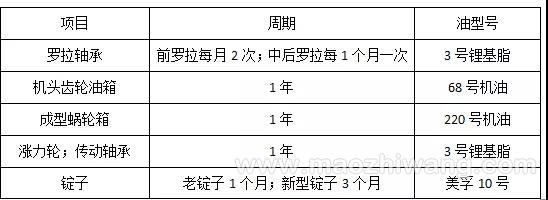
4.2.2 Regular cleaning and maintenance items
(1) Front, middle and rear roller grooves and bearing dead flowers. (2) Clean the spindle back wire and the steel collar board. (3) Clean the ingot hook flower and tension disk flower. (4) Clean the sling and the rotor. (5) Clean the large shaft connection and clean it. (6) Clean up the size of the sheep's feet and accumulate flowers (7) Clean the cradle, the upper pin, the lower apron and the tension frame. (8) Make a wire washer cleaner. (9) Check if the tension frame is flexible. (10) Replace the pick-up and back-grinding top rollers. (11) Check the front, middle and rear roller gauges (key maintenance). (12) Replace the upper and lower aprons according to the cycle (key maintenance). (13) Flat school steel collar plate, fender triangle iron (key maintenance). (14) Knocking spindles and hanging wires (key maintenance)
5. Regular brake and maintenance cycle adjustment of the spinning frame
Based on the spinning machine, the decomposition and optimization of the maintenance project, we cut the head, current, machine parts and self-distribution for the spinning of thousands of spindles according to different spinning varieties, cotton blending conditions, spinning process, workshop environment and driving speed. In this aspect, the yarn has been subjected to a large number of tracking and monitoring tests, and different periodic braking and maintenance cycles have been formulated.
5.1 Different spinning varieties
5.1.1 Ring spinning
Different types of carded yarns are different in height, different periodic brakes and maintenance cycles:
For example: carding 40S, carding 20S, we are tracking the test on the same car for the carding 40S and the carding 20S respectively:
The operation status of Carding 40S in different periods after regular braking and maintenance
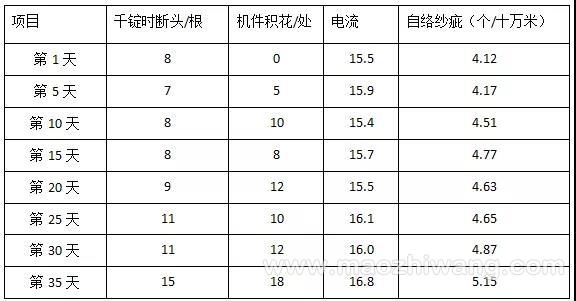
The operation status of the carded 20S in different periods after regular maintenance and braking
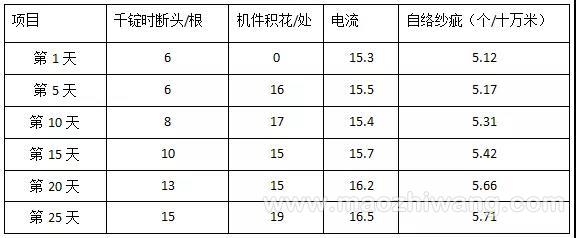
According to the above data analysis: the data of the carding 40S and 20S spinning machines are gradually increased on the 30th day and the 20th day after the regular braking and maintenance. We initially set the 40S, 20S spinning frame to regularly brake and maintain the cycle. 30 days and 20 days respectively.
5.2.2 Compact spinning:
The length of the combed yarns is different, and the regular brakes and maintenance intervals are different.
For example: combed compact spinning 20S, combed compact spinning 40S, compact spinning due to the addition of a collecting device in the drafting zone of the ring spinning machine, the increase of equipment parts, the corresponding increase in maintenance and maintenance items, and the addition of the assembly device After that, it is easy to cause the piles to accumulate short velvet. These problems all affect the quality of the products.
We tracked and observed the compact spinning combed 20S after regular braking and maintenance. On the 5th day after regular braking and maintenance, 2 spindles were found to be spinning under bad conditions. On the 7th day, 3 were found. The spindles are spun in a bad state, which means that three spindles in one car are producing unqualified products. They are:
(1) The accumulation of flowers between the grid ring and the tension frame.
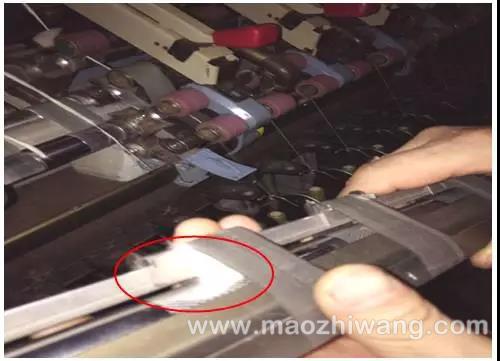
(2) Entangled flowers in the grid circle and on the back roller.

(3) Lower apron injury.
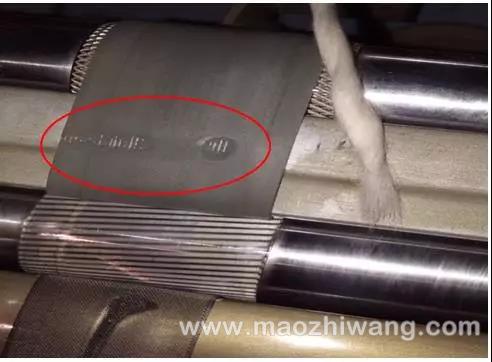
At the same time, we observed that the combed compact spinning 40S had no problems when it was regularly braked and repaired on the 10th day. On the 15th day, it was found that three spindles were in a bad spinning state, and at the same time we broke the head, current and self. According to the statistics of the 100,000-meter yarn crepe, the combed compact spinning 20S and 40S have different degrees of increase on the 7th and 12th days respectively. According to the above situation, we will set the regular spinning and maintenance cycle of the combed compact spinning 20S as 7 days, the regular brakes for the combed compact spinning 40S, the maintenance cycle is set to 12 days.
5.2.3 Different cotton blending and spinning processes
Regular braking and maintenance intervals for combed varieties and carded varieties.
For example: combed 40S, carded 32S, combed varieties generally use the original cotton quality, the length of the fiber body is long, the short pile rate is low, and at the same time combing the comber, and excluding most of the short velvet, in the spun yarn During the spinning process, fewer short fibers are detached from the sliver, resulting in less flying flowers and less contamination of the spinning frame. After testing the indicators such as the broken head, the current, and the self-propagating 100,000-meter yarn defect of the combed 40S and the carded 32S, the regular braking and maintenance cycle of the combed 40S and the carded 32S are respectively determined. For 30 days and 25 days.
5.3 Adjust other conditions of the maintenance cycle.
In addition, when the temperature and humidity changes in the workshop and the spindle speed difference are large, which affects the operation and cleaning state of the spinning frame, the regular brake and maintenance cycle of the spinning frame should be adjusted appropriately.
Through the decomposition and optimization of the spinning machine maintenance project, the equipment maintenance methods of cleaning, state maintenance and different regular brake maintenance were implemented for different varieties, cotton blending, spinning process and workshop environment. After nearly one year. The operation has achieved good results.
According to statistics, compared with the traditional half-month spinning frame maintenance cycle previously used, equipment failures decreased by 33%, equipment maintenance labor decreased by 26%, machine materials decreased by 18%, and planned shutdown rate decreased by 2.5%. The utilization rate of the equipment ensures the quality of the products and improves the comprehensive benefits of the company.
A bump cap is a type of head protection gear that is designed to protect the wearer from minor head injuries caused by bumping into low-hanging objects or hitting the head against hard surfaces. Unlike traditional hard hats, bump caps are made of lightweight materials such as plastic or foam and are designed to be worn in low-risk environments such as warehouses, factories, and construction sites. They are also commonly used in industries such as automotive, food processing, and maintenance. Bump caps are not intended to provide protection against falling objects or high-impact collisions and should not be used as a substitute for hard hats in high-risk environments.
Custom Bump Cap For Sale,Bump Cap For Sale,Bump Hats For Sale
Yantai Belief Cap Co.,Ltd. , https://www.beliefcap.com
![<?echo $_SERVER['SERVER_NAME'];?>](/template/twentyseventeen/skin/images/header.jpg)